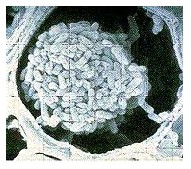Mar
31
Using Protein and Bacteria to Make Renewable Petroleum
March 31, 2011 | 1 Comment
U of M researchers have closed in on a technology for making renewable “petroleum” using only bacteria, sunlight and carbon dioxide to make the raw materials. While it’s not a fully scaleable process yet, there is considerable excitement, even though the U of M press release is quite low key. The week seems bereft of graphics, but some of the announcements have been a bit over the top this one is not. The study results are published at The Journal of Biological Chemistry.
The U of M team is using Synechococcus, a bacterium that fixes carbon dioxide in sunlight and converts CO2 to sugars. Next, they feed the sugars to Shewanella, a bacterium that produces hydrocarbons. This turns CO2, the gas produced by combustion of fossil fuel petroleum, back into hydrocarbons.
In this study, OleA a protein from Xanthomonas campestris was expressed in Escherichia coli and purified to homogeneity. The purified protein was shown to be active with fatty acyl-CoA substrates that ranged from C8 to C16 in length, the main carbon content used in making fuel molecules from gasoline to diesel. This trues up data being consistent with the OleA protein catalyzing a non-decarboxylative Claisen condensation reaction in the first step of the olefin biosynthetic pathway previously found to be present in at least 70 different bacterial strains.
The catch in all this is the lab is working in vitro, and whether or not it will work in vivo is yet to be seen. Hope springs eternal, but as noted there are already 70 strains of bacteria to work through.
Frias made the intuitive breakthrough, but others are hard at this as well. Larry Wackett, Distinguished McKnight Professor of Biochemistry, is lead author. Other team members include organic chemist Jack Richman, a researcher in the College of Biological Sciences’ Department of Biochemistry, Molecular Biology and Biophysics, and undergraduate Jasmine Erickson, a junior in the College of Biological Sciences. Wackett, who is senior author, is a faculty member in the College of Biological Sciences and the university’s BioTechnology Institute.
The team’s production is at enough scale that Aditya Bhan and Lanny Schmidt, chemical engineering professors in the College of Science and Engineering, are turning the ketones into diesel fuel using catalytic technology they have developed.
The team is showing an ability to produce ketones, which opens the door to making petroleum-like hydrocarbon fuels using only bacteria, sunlight and carbon dioxide. Well, there is a lot more, water in particular and a significant amount of facility. But the point is understood.
Wackett says, “There is enormous interest in using carbon dioxide to make hydrocarbon fuels. CO2 is the major greenhouse gas mediating global climate change, so removing it from the atmosphere is good for the environment. It’s also free. And we can use the same infrastructure to process and transport this new hydrocarbon fuel that we use for fossil fuels.”
The research is funded by a $2.2 million grant from the U.S. Department of Energy’s Advanced Research Projects Agency-energy (often seen as ARPA-e) program. The U of M group is the only group using a photosynthetic bacterium and a hydrocarbon-producing bacterium together to make hydrocarbons from carbon dioxide.
The process, if one can call the procedure that, is still quite long and entails more than one modified bacteria. That opens the door to extended effort at designing bacteria for closing up the procedure. Where this might all lead is still conjecture, but the basics, getting the bio organic chemical activity done in living organisms seems in hand now.
It’s a very long way to 90 million barrels a day, but those precious drops of bio synthesized petroleum in Minnesota do offer a certain hope. Let’s not be losing track of the necessary CO2.
Comments
1 Comment so far



I need your paper for MS thesis,
thank you so much